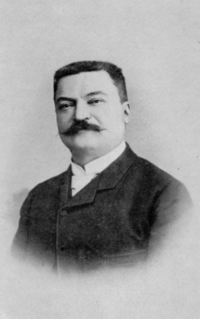
In mathematics, the Fibonacci numbers, commonly denoted Fn, form a sequence, the Fibonacci sequence, in which each number is the sum of the two preceding ones. The sequence commonly starts from 0 and 1, although some authors omit the initial terms and start the sequence from 1 and 1 or from 1 and 2. Starting from 0 and 1, the next few values in the sequence are:
In mathematics, a Fermat number, named after Pierre de Fermat, who first studied them, is a positive integer of the form

François Édouard Anatole Lucas was a French mathematician. Lucas is known for his study of the Fibonacci sequence. The related Lucas sequences and Lucas numbers are named after him.
In number theory, a Wall–Sun–Sun prime or Fibonacci–Wieferich prime is a certain kind of prime number which is conjectured to exist, although none are known.

The Lucas numbers or Lucas series are an integer sequence named after the mathematician François Édouard Anatole Lucas (1842–91), who studied both that sequence and the closely related Fibonacci numbers. Lucas numbers and Fibonacci numbers form complementary instances of Lucas sequences.
300 is the natural number following 299 and preceding 301.
2000 is a natural number following 1999 and preceding 2001.
3000 is the natural number following 2999 and preceding 3001. It is the smallest number requiring thirteen letters in English.
In mathematics, a double Mersenne number is a Mersenne number of the form
In mathematics, the Lucas sequences and are certain constant-recursive integer sequences that satisfy the recurrence relation
Lucas pseudoprimes and Fibonacci pseudoprimes are composite integers that pass certain tests which all primes and very few composite numbers pass: in this case, criteria relative to some Lucas sequence.
In number theory, a Frobenius pseudoprime is a pseudoprime, whose definition was inspired by the quadratic Frobenius test described by Jon Grantham in a 1998 preprint and published in 2000. Frobenius pseudoprimes can be defined with respect to polynomials of degree at least 2, but they have been most extensively studied in the case of quadratic polynomials.
A Fibonacci prime is a Fibonacci number that is prime, a type of integer sequence prime.
257 is the natural number following 256 and preceding 258.
In number theory, a perfect totient number is an integer that is equal to the sum of its iterated totients. That is, we apply the totient function to a number n, apply it again to the resulting totient, and so on, until the number 1 is reached, and add together the resulting sequence of numbers; if the sum equals n, then n is a perfect totient number.
In mathematics, the Jacobsthal numbers are an integer sequence named after the German mathematician Ernst Jacobsthal. Like the related Fibonacci numbers, they are a specific type of Lucas sequence for which P = 1, and Q = −2—and are defined by a similar recurrence relation: in simple terms, the sequence starts with 0 and 1, then each following number is found by adding the number before it to twice the number before that. The first Jacobsthal numbers are:
In mathematics, the Lucas–Lehmer–Riesel test is a primality test for numbers of the form N = k ⋅ 2n − 1, with k < 2n. The test was developed by Hans Riesel and it is based on the Lucas–Lehmer primality test. It is the fastest deterministic algorithm known for numbers of that form. For numbers of the form N = k ⋅ 2n + 1, either application of Proth's theorem or one of the deterministic proofs described in Brillhart-Lehmer-Selfridge 1975 are used.
9000 is the natural number following 8999 and preceding 9001.
In mathematics, an integer sequence prime is a prime number found as a member of an integer sequence. For example, the 8th Delannoy number, 265729, is prime. A challenge in empirical mathematics is to identify large prime values in rapidly growing sequences.
In mathematics, the Perrin numbers are defined by the recurrence relation



